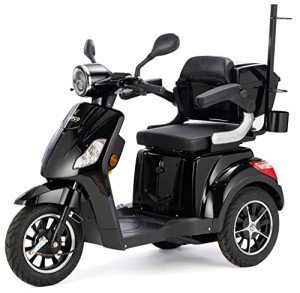Do Not Believe In These "Trends" About Mobility Scooter

A Comprehensive Guide to Buying a Mobility Scooter
Mobility scooters have become a crucial tool for lots of individuals aiming to improve their independence and mobility. With a huge range of designs and features available, selecting the best mobility scooter can be daunting. This article supplies a useful guide to assist consumers browse their options, evaluate their needs, and make an informed purchase.
Understanding Mobility Scooters
Mobility scooters are electric cars developed for people who experience mobility obstacles. They are particularly advantageous for seniors, those with specials needs, or individuals recuperating from injuries. Mobility scooters can vary extensively in terms of style, functions, and prices.
Types of Mobility Scooters
Before starting a purchase, it's important to understand the various kinds of mobility scooters offered:
Three-Wheel Scooters:
- Generally more maneuverable in tight spaces
- Lightweight and portable
- Perfect for indoor use
Four-Wheel Scooters:
- Offer higher stability and balance
- Appropriate for outdoor usage over various surfaces
- Typically have a longer battery life
Foldable/Portable Scooters:
- Designed to be quickly transported and saved
- Can often suit the trunk of a cars and truck
- Ideal for those who travel often
Durable Scooters:
- Built to accommodate bigger individuals
- Often come with more robust features for outdoor use
- Usually geared up with bigger batteries for prolonged variety
Factors to Consider When Buying a Mobility Scooter
1. Weight Capacity
Choose a mobility scooter that can support the user's weight. Many scooters have a weight limit ranging from 250 to 500 pounds. It is essential to make sure that the scooter can accommodate the user conveniently.
2. Variety and Battery Life
The range is how far the mobility scooter can take a trip on a single charge. Common ranges vary in between 10 to 30 miles. Think about the user's everyday activities and choose a scooter with an appropriate variety.
3. Scooter Dimensions
Consider the size of the scooter, including its weight and dimensions. A more compact scooter may be ideal for narrow corridors and tight spaces, while larger models offer additional stability and convenience.
4. Terrain Capability
Evaluate where the scooter will mostly be used. If the user plans to travel mostly on pavement, a lightweight model might suffice. Nevertheless, if the user requires to traverse gravel or irregular surface areas, think about a four-wheel scooter built for off-road usage.
Leading Features to Look For
Convenience
- Adjustable Seats: Look for scooters with cushioned and height-adjustable seats to make sure comfort throughout travel.
- Armrests: These enhance safety and assistance while navigating.
Security and Visibility
- Headlights and Taillights: Essential for nighttime use.
- Turn Signals and Reflectors: Improve visibility and safety while on the roadway.
User-Friendly Controls
- Joystick or Drive Controls: These should be intuitive and simple to manipulate.
- Easy-to-Read Displays: A control panel that reveals battery life, speed, and range can improve the user experience.
Extra Features
- Storage Compartments: These provide added convenience for bring personal products while on the go.
- Weather Protection: Consider models with rain covers or windshields if utilized in variable climate condition.
Cost Considerations
When budgeting for a mobility scooter, rates can vary anywhere from ₤ 500 to over ₤ 5,000 depending on the design, features, and brand name. Extra expenses might consist of:
- Extended Warranty: Protects versus defects and can save cash in the long run.
- Devices: Optional functions, such as updated seats, lights, or storage options.
| Function | Cost Range |
|---|---|
| Standard Models | ₤ 500 - ₤ 1,500 |
| Mid-Range Models | ₤ 1,500 - ₤ 3,000 |
| High-End Models | ₤ 3,000 - ₤ 5,000 |
Funding Options
Many sellers provide funding strategies, and some city government efforts may provide grants or support for those in need. Investigate mouse click the up coming website page with community resources or mobility service companies.
Frequently asked questions about Buying a Mobility Scooter
What is the distinction between a mobility scooter and a wheelchair?
Mobility scooters are motorized and allow users to navigate individually, while wheelchairs may need physical help or manual operation.
How do I preserve a mobility scooter?
Routine upkeep includes examining battery life, cleaning the scooter, and examining tires and brakes. Always refer to the user handbook for particular standards.
Can mobility scooters be utilized inside?
Yes, many models are designed for both indoor and outside use. However, three-wheel scooters tend to be much better fit for indoor navigation due to their tighter turning radius.
Are mobility scooters covered by insurance coverage?
Some insurance prepares cover a portion of the expenses for mobility scooters if they are deemed medically necessary. Contact your supplier for specific details.
How quick can a mobility scooter go?
Most mobility scooters have an optimal speed varying from 4 to 8 mph. However, the appropriate pace may vary depending upon local guidelines.
Acquiring a mobility scooter can significantly improve one's self-reliance and quality of life. By understanding the types, functions, and expenses associated with mobility scooters, potential buyers can make well-informed choices that suit their needs and choices. Customization and extensive research study are key to guaranteeing complete satisfaction with this important financial investment.

